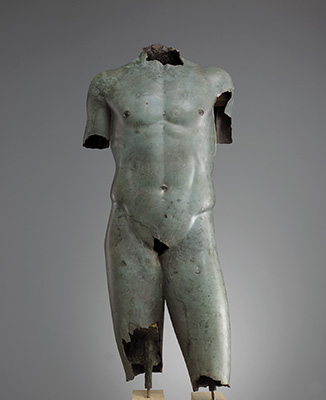Vani, 2nd century BC, GNM: 2:996-43

Excavated in 1988, this stunning bronze torso was discovered along with small fragments of other bronze statuary on Vani’s central terrace. All of this statuary seems to have been deliberately destroyed when the city was sacked in the middle of the 1st century BC. The statue’s precise date of manufacture is difficult to determine. Given the history of the site, however, a date in the flourishing 2nd century BC seems most likely.
The torso shows a well-proportioned youth in Early Classical style. In the Greek world, statuary of this type was used to honour victorious athletes. Here, its purpose remains unclear. The extraordinary attention paid to the rendering of the physique, combined with its slightly stiff pose, recalls famous Greek works dating to about 490–460 BC, such as the famous marble statue from the Athenian Acropolis known as the Kritios Boy.
Both the alloy and the technique strongly suggest that the statue was not imported, but rather a local product by a sculptor who produced work in a Greek style. Analysis of the statue’s metal shows that the composition of the alloy differs significantly from that of Greek bronzes and reflects the use of local materials. The statue was made using a “lost wax” technique where a wax model was carefully sculpted with varying thicknesses over an armature and then covered in a heat-resistant material that was equipped with a network of flues and pour channels. Molten bronze was then poured in through the channels thereby forcing the wax to flow out of the flues.
The torso was very carefully worked-over after casting in order to minimize defects. For example, there are 34 patches on the left thigh, and a large crack down the right buttock has been painstakingly filled so that it is almost invisible to the naked eye. Other notable details are the missing areolae and nipples, which were made separately, probably of copper, and the finely incised, light pubic hair. This youthful detail is one that is not preserved on Greek statues and may reflect a local tradition.




